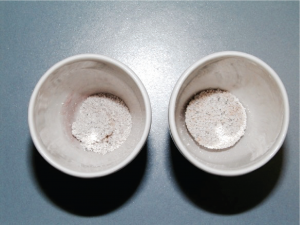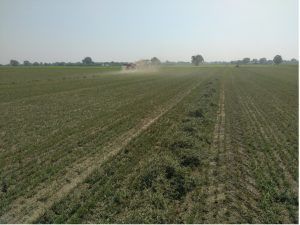
Ash is defined as the total mineral content of forage and is comprised of minerals contained within the plant, i.e., internal ash, and soil contamination, i.e., external ash.
Internal ash is a naturally occurring mineral found in plants, some of which have nutritional value to livestock, for example, calcium, potassium, phosphorus, magnesium, and copper. External ash provides no nutritional value to animals and is associated with soil contamination that was either splashed onto the surface of the plant while in the field or was picked up during harvest.

If the organic matter in the plant is burned only inorganic matter remains, which represents the total ash.
Total ash is comprised of minerals contained within the plant and soil contamination.
On average, cool-season grass forages have 5 to 6 %, while legumes have 6 to 8 % internal ash on a DM basis. The remainder of the ash is dirt. Cool-season grasses hay or silages have about 7 to 9 % and alfalfa hay or silages have 10 to 12 % total ash on average.
Generally, mineral concentrations decrease as plants mature and are greater in forages grown in soils that contain high concentrations of available potassium. Typical concentrations are in the range of 8 to 10 %. Wrong harvesting practices and machinery operation, soil, and weather conditions at harvest can increase ash concentrations by 5 to more than 15 % points.
High ash content in forage is caused by both, wet weather with wet soils and muddy conditions and dry weather with dusty conditions. Factors such as rodent holes, previous flooding, wheel tracks, and gravel roads will also contribute to higher ash values in localized field areas.
Though it’s impossible to keep all soil contamination out of harvested forage, 10 tips that can be implemented to minimize forage ash content:
- Do not cut forage until it has dried because dirt will be less likely to stick on dry forage.
- Avoid harvesting lodged forage as dirt often sticks to the downed forage when the ground is wet or very dry.
- Avoid pitching the cutter bar downward at too steep an angle. Set the flotation height to avoid scalping the soil surface and wavy cutting height.
- Do not cut too low. Though a low cutting height offers more yield potential, it also results in more soil being picked up by the mower and deposited on the forage. Set the cutting height at 5 to 7.5 cm and if conditions are wet, set it between 10 to 15 cm.
- Use sharp knives on the mowers to ensure smooth and even mow.
- Make wide swaths. This will not only speed the drying rate but will also keep the wilting forage on top of the stubble and off the ground.
- Make sure tedders and rakes are properly adjusted not to scratch the ground.
- Use pick-up rakes if possible. They pick up the forage from the ground and do not sweep it into the swath.
- Control rodents because their dirt mounds are easily incorporated into forage windrows.
- Keep storage areas clean, on well-drained, solid surfaces.

Heavy rains have the potential to splash soil particles onto forage, especially if the forage is lodged.
Harvesting in very dry conditions or on sandy-type soils also introduces a lot of dust and stones
into the forage.
All resources can be viewed here.












